This is it people. The true beginning. After two chapters to set things up, chapter
3 is where the primary plot of Senran Kagura 2 begins, and the game lets you
know it. Just like the first chapter,
chapter 3 opens with a poetic scroll reading, except this time it’s not about
the shinobi, but rather some sort of powerful entity known only as Kagura.
No.
No.
That is very clearly Ikaruga!
What Kagura is in exact terms
isn’t fully explained, but the scroll does give some of the basic ideas. Kagura is the the bane of all youma and all
shinobi look up to her power, which I assume is the game’s way of implying the
Kagura rank in the versus games without going into technicalities. She is “a flower with a fleeting lifespan and
with the blood of youma it will bloom.”
I think the flower they’re supposed to be referring to and the one the
game keeps showing is the red “tsubaki” flower, also known as the camellia
flower. In Japan
the tsubaki represents divinity as well as perishing with grace, both of which
play into Kagura’s character.
If you’re actually paying
attention, the scroll also says that Kagura is a “Senran Kagura.”
The word “Senran” isn’t a real
word. It’s a combination of the kanji
for “brandish” and “war”. Kagura is of
course a type of traditional Japanese dance.
In this instance, XSEED translated Senran Kagura as “Shining
Revolution”, which works because she is a “moment of light that flashes in
battle”, much like how shinobi shine their brightest before their lives come to
an end in battle.
So now that we know what Senran
is supposed to mean, let’s stop misusing the word like it refers to the
characters.
The poetic dialogue explains what
Kagura is without actually explaining what Kagura is. The real explanation doesn’t happen until later. It’s not so much for some kind of twist, but
for a replay bonus. Once you know what
Kagura is (or at least have a general guess as the game goes on), the opening
scroll makes more sense. Not knowing is
also part of the player engagement, as we’ll see later.
To start off with some suspense,
the scroll is followed-up by a cutscene in which a girl named Naraku is
carrying a little girl in her arms, running from a pack of armored figures
known only as the youma generals. If
Naraku knew what to call them, she must’ve been running from them for some
time.
Right away the cutscene shows
there’s something unique about the youma generals. All of them attack Naraku in formation with
ninja speed, even visibly injuring her and drawing the only bit on onscreen
blood ever in the entire franchise.
Youma are supposed to be mindless, raging monsters, so seeing them
synchronize like that tells us that they’re not ordinary youma. It also shows that Naraku is one hell of a
protector. There are 10 of them and she
has been fending them all off with her hands full!
But that’s only a glimpse. Before that plot can begin, the rest of the
characters need to meet her. It’s road
trip time!
Cutting from the action of
Naraku’s chase to characters preparing for a vacation helps imply that Naraku
has been going at it for a long time without any of the characters being aware
of who she is. It shows that Naraku has
been tough enough to handle herself without the need of anyone else and the
main characters can go about their daily lives without even being aware of
it. Naturally that’ll all change when
they meet.
Homura’s team is getting ready to
head to Kyoto ,
a very popular place for tourists, as we’ll inevitably see. Yomi won a trip there from a lottery at the
shopping district, but ironically, she’s the only one not excited to go. They need to ride a shinkansen (bullet train)
to get there and Yomi is terrified of it.
That’s understandable, especially to some U.S. players. She’s never ridden one and the idea of a
train that goes 120 miles per hour is pretty intimidating. It’s little things like this that show even
with all their ninja training, there are still things in everyday life they
have to worry about or aren’t used to.
Yomi gets a sigh of relief when
Homura seems to lose the tickets because Homura is not very careful.
But their leader comes up with a better idea:
ride on top. Better yet, train on top of
the train! Everyone is quick to point out
how stupid it is. Even on a regular
train they could very easily fall off, let alone a bullet train!
 |
| Oh Yomi. Trains are perfectly safe. Remember Star Fox? |
But, as established, Homura isn’t
much of a thinker. She just has them do
it, with the exception of Haruka. She
thought ahead and got an extra ticket for herself. She knows Homura too well.
A bullet train is a fun backdrop
for the player to have a spar, but not so much for the characters themselves. During the fight everyone is yelling in fear
that they’re really going to die, but thankfully you can’t actually fall off,
which is…. Impossible. They can jump on
the train and for some reason it doesn’t zip right under their feet and throw
them off. I remember a shinkansen battle
going a bit differently in
The Wolverine.
Frankly I’m not even sure how
they can hear each other either. I would
think that blinding speed would make them deaf or the wind would drown out their
voices. I greatly question the physics
of this game of fighting bunnies and transforming ninja girls!
 |
| They're like Hardcore Max! |
As it turns out, however, they
never needed to stay on the roof at all.
Homura finds the tickets in one of her pockets.
At Mirai’s suggestion she hands them to Yomi for safekeeping until the
next train stop, but when the wind speed is going over 100 MPH…
 |
| I like customizing outfits, in case you couldn't tell. Mirai is supposed to be Mercedes from Odin Sphere. |
So they’re stuck up there. When Haruka comes up to check on them, the exhaustion and lack of oxygen has already made Yomi and Mirai go loopy, resulting in one more
mission to beat the sense back into them.
 |
| Plot twist! |
There’s a glimmer of hope when Haruka tells them about the free
passenger seating, but she didn’t realize there isn’t another stop until Kyoto , so she’s stuck up
there with the rest of them. At least
Homura stopped the training.
As if things couldn’t get any
more humiliating for Homura’s team, the Hanzo girls are shown safe and sound
down in the passenger car, playing the same card game they did when they took
the train to the beach in the first game.
They think they hear something, but nah.
At this point the story
officially moves to Kyoto . It was only barely pointed out, but in the
previous Senran Kagura games the story largely took place in the Asakusa
district of Tokyo and most of the locations were based off of real life. Now in Kyoto
there’s going to be a lot more of that at historic sites I’ll try to point
out as they come up, for those interested.
As I said in the review, the locations are more targeted toward the
Japanese audience that recognizes them, but I still think it’s neat getting to
see and fight at these foreign tourist spots.
The hub you spend time at in
between missions also changes. In the
first chapter, it was the Hanzo academy homeroom taken straight from Shinovi
Versus and the original game, while in the second, it was in the cave Homura’s
team lived in from Shinovi Versus. Now in Kyoto ,
both teams sit around in hot spring (onsen) hotel rooms adjacent to
each other wearing hotel bath robes.
When it comes to places to relax in Kyoto while on vacation, you can’t beat that.
 |
| Is that a 3DS? |
The Hanzo girls are in Kyoto for a school trip,
chaperoned by Kiriya. It looks like
it’ll be a peaceful one, but not long after arriving they see Naraku being
attacked by the humanoid youma seen earlier, which now show they are capable of
setting up shinobi kekkai barriers.
 |
| Nan Yaegashi specializes in cutesiness, but he can also draw great villain shots like this. |
That one small bit about good
shinobi not being allowed to attack youma without permission hints at something
greater. If Hebijo students encountered
a youma, someone like Homura would absolutely be allowed to be impulsive and
attack it. Hebijo is sink or swim anyway.
The Hanzo students of the nation,
on the other hand, are smaller in number and their higher-ups need to be in tactical
control of their ninjas like the trained soldiers they are. They have more regulations they need to
uphold and that conflict of order vs. chaos is going to cause some friction
down the line.
Something should be immediately
apparent about the youma generals when you fight them: they mimic each of the
10 students. At first I thought that was
a cheap way to make them little more than fights against other shinobi with a
new coat of paint, but after observing them closer, I really like them as evil
Psycho Rangers-style counterparts.
Each one of the youma generals
are ranked by “seats”. With the
exception of the first and second seats (based on Asuka and Homura), they all
wear drab, black armor all over their bodies, including their faces. They also have cloud tassels for an
otherworldly touch and all of their waists and chests are tied by rope with an tassel knot for that traditionalist look.
The gray armor is a nice
antithesis to the expressive outfits the girls wear. The playable characters wouldn’t be caught
dead wearing something like that, except maybe the first and second seat’s colorful
armor. In fact an outfit based on the first seat’s is DLC
in Estival Versus.
 |
| Not as intimidating. |
Their personality-less armor suits their character, namely the fact that they have no personality. The youma generals seem to be capable of
working together, but they still aren’t shown to have any kind of motive outside of attacking Naraku and Kagura along with anyone who gets
between them. All they can do is make
growls and screeches. With other ninjas
the main characters have been able to come to understandings on some level, but
the youma generals can’t be bargained with.
They can’t be reasoned with. They
don’t show pity or remorse or fear (although they’re smart enough to
retreat). And they will absolutely not
stop, ever, until you are dead.
That also contributes to the
game’s theme of individualism. Even if
they’re following orders, every one of the human characters are still
people. If they only did as they were
told and their entire lives were nothing but being a ninja, the youma generals
are somewhat of a representation of what they would be like. They’re the mindless machines that Dougen
wanted. If the Iron Giant is not a gun
then the youma generals are.
Yet despite all of this, each one
has their own distinctions with their headgear, evil weapons and exclusive hidden
ninpo.
There's an interesting translation story regarding the youma general's weapons. In Japanese, their names are single kanji for something dark or evil. Single kanji doesn't translate well into English, so XSEED instead got creative with naming them. Very special thanks to XSEED's Ryan Graff for giving me the untranslated names of the weapons.
There's an interesting translation story regarding the youma general's weapons. In Japanese, their names are single kanji for something dark or evil. Single kanji doesn't translate well into English, so XSEED instead got creative with naming them. Very special thanks to XSEED's Ryan Graff for giving me the untranslated names of the weapons.
Let’s start with the first two
shown. The tenth seat is modeled after
Haruka. Since Haruka is a scientist, it
has a mad scientist’s static hair and glasses.
Its weapon is a substantially less cuddly boxing robot called that
fights with spiked fists and has a wooden head in its bucket-like body for a
creepy decapitation image. The Japanese kanji for it is "屍", meaning "shikabane" or "corpse." For the translation they named it Death for a recurring Horsemen of the Apocalypse theme.
Most of Haruka’s alternate weapons have silly objects in place of her robot’s boxing gloves, but Death’s is straight-up lethal spiked bludgeons. In its hidden ninpo the tenth seat rides its weapon as it spins around like a tornado.
Most of Haruka’s alternate weapons have silly objects in place of her robot’s boxing gloves, but Death’s is straight-up lethal spiked bludgeons. In its hidden ninpo the tenth seat rides its weapon as it spins around like a tornado.
The ninth seat mimicking Hibari
has a puffy hair style I think is supposed to be a “cutsey” style in Japan ,
like Midori’s hairstyle in Guitar Hero.
That would make sense, as Hibari is definitely the most innocent and
cutesy of the heroes.
Instead of Hibari’s white,
cartoonish, perky-eared bunny Ninto for a weapon, the ninth seat has a black,
more realistic-looking, floppy-eared bunny-like creature. In Japanese its kanji is "穢" basically meaning filth, so the translation names it after a certain kind of filth: Cecotrope, another name for rabbit dung. Her
hidden ninpo has her dash across the field on Cecotrope in a much more extreme
version of Hibari’s basic ground ninpo.
The first fight takes place at the old capital where there’s a lot of
open space, so the ninth seat has plenty of space to show off the distance its
ninpo goes.
The youma generals have so many
small details put into their conception that there’s already a page worth to
admire about them from a narrative and design standpoint. To top it all off, I love their battle
music. I never get tired of it. It has a lot of sick guitar licks and
suspenseful chords with a heavy metal rhythm.
Since the player got to use
Homura’s team in tag teams for the previous chapter, the Hanzo girls get a try
now, starting with Katsuragi and Ikaruga against the tenth and ninth
seats. I like their tag ninpo. It has Ikaruga batting Katsuragi into the
enemy and their victory pose has Ikaruga punching her for being too
touchy. I know it’s Katsuragi’s way of
being playful, but it’s annoying and uncomfortable so I love seeing characters
strike back like that.
As those two buy time to get
Naraku to safety, Kiriya is called back to Tokyo on an emergency summons to meet with
the ninja council. For the first time in
the series there’s a look at the greater organization the Hanzo students work
for. Based on how it looks, the nation’s
ninja council is olden and traditional.
Their meeting is held in a candlelit room where all the councilmen sit
in robes. It’s kind of like the ninja
equivalent of conservative suit-wearing old white men in the White House only I don’t think
the ninja council is supposed to be comprised of fascist white supremacists.
The youma generals in Kyoto are the least of the
problems at hand, it seems. All of Japan
is being overrun by youma and every ninja the council has is spread out too
thin to deal with the widespread problem.
Since they’re low on manpower, they officially assign the Hanzo
students, girls who have not even
graduated and are still learning, to eliminate the youma in Kyoto . In other words, help isn’t coming. Everyone’s busy.
But there is one more assignment
on top of that: a capture mission for a particular person of interest and you
can probably guess who that is.
I have to say, like the youma
generals and their organized fighting, it’s odd that there would be a sudden
country-wide surge of youma. It’s like a
planned invasion of some kind, but youma don’t plan. Hmmmmmm….
Back in Kyoto , Yagyuu, Hibari and Asuka stick with
Naraku to protect her, but she isn’t very grateful about it. Naraku is actually rather rude to the
ninjas. She only stops being mean when
the little girl she’s with acts as the voice of authority and tells her to.
Yagyuu and Hibari both fend off
the eighth, seventh and sixth seats on the stage of Kiyomizu-Dera. Yagyuu insists that Hibari leave it to her,
but Hibari wants to fight and tells her that she can handle herself!
Yagyuu being overprotective of
Hibari and wanting to do everything to support her has always been her biggest
flaw and a complaint among some players of the games, so seeing her have to deal
with Hibari not wanting Yagyuu to do everything for Hibari's sake is a big
step in her character development.
Hibari too is also far more confident in her abilities than the girl who
was feeling down on herself for her many mistakes in the first game.
 |
| I just had to use that heart halo somewhere. |
It looks like a smooth mission
when the only opponent shown is the eighth seat youma general, but after that
you’re double-teamed by the sixth and fifth as well.
The eighth seat is Mirai’s youma
counterpart. Since it uses Mirai’s guns
and weaponry, it wears a green beret with a patch depicting Hebijo’s insignia. In case you’ve never read any kind of war
story ever, green berets are a very iconic military cap worn by British
commandos and U.S. Special Forces. I
guess it’s possible the green color is supposed to represent Hebijo’s school
color though.
Its weapon's kanji in Japanese is "屠", meaning slaughter or massacre. Like Death, the translation gives it the name of a horseman of the apocalypse also known for massacres: War, referring
to the use of guns in war. It’s not too
much different from Mirai’s default weapons (a gun’s a gun, right?), but it
notably replaces her umbrella with a bayonet-equipped machine gun and her grenade
launcher with a bazooka, both of which are more lethal-looking.
It doesn’t use all the weapons. It only fires out black energy balls by
swinging its rifle, something Mirai could do with her umbrella in Shinovi
Versus, but not in this game. Since you
can bat projectiles back at enemies in Senran Kagura 2, that’s the best tactic
for fighting it.
For its ninpo the eighth seat
does a handstand, somehow turns its legs into machine guns and does a
breakdancing spreadshot twirl with them.
A page taken from Bayonetta, perhaps.
The seventh seat is the Yagyuu
mimicry, who wears a dark, straw hat with cloth covering most of its face. It’s based on how ninjas used to be in real
life, where they would disguise themselves as peasants and conceal their identity
for spying and assassinations. Remember
the Yu-Gi-Oh card Shien’s Spy? That’s
what that is.
Or an even better, multicultural
example:
Either it looks that way to
represent Yagyuu's reserved nature and her reluctance to open up to people or it's supposed to fit with the paper oil fan, which can be concealing and was often used in
the times of those ninjas, as opposed to Mirai’s modern-day, metal-framed
umbrella. I’ll go with either.
The seventh seat’s weapon is a drab, grey umbrella with a black spiral on it. Its kanji is "弔", meaning sympathy or condolences. In English they named it Funeral Rain for the depressing rain often depicted for funerals, where condolences and sympathies are more prominent. I think the spiral pattern is a reference to how the general and Yagyuu
spin their umbrellas to attack with them, but I’ll just say it’s referring to
this:
Beyond the weapon, the seventh
seat’s difference from Yagyuu is that it summons an evil counterpart to
Yagyuu’s squid with purple and light blue stripes all over it. For its ninpo the seventh seat has it swim
across the ground for a charging strike.
The sixth seat is based on Hikage
and has red hair in what one might call an “emo” haircut. I think the haircut sort of representins
Hikage’s reclusiveness and social problems, with the red hair being a unique
color to the other general’s just like Hikage’s green hair is to everyone
else. Its weapons are a set of black
knives with the kanji "禍" in Japanese, pretty much meaning the source of a problem or a root of evil. In English it's called Pestilence, the Horseman of disease, which is kind of similar in that disease is the most baseline and natural ways people die. It's neat how well the Horseman of the Apocalypse naming lined up with the kanji.
_6.png/revision/latest?cb=20151013032859) |
| Not much different from the other knives, to be honest. |
For a ninpo, the sixth seat
emphasizes the speed and acrobatics of Hikage’s knifeplay by teleporting over
its target and striking from above, so when it kneels down and gets briefly
covered in an aura of darkness it’s time to get ready to dash out of the way.
Fighting the three of them is the
first time the player fights with Yagyuu and Hibari, with their special
introduction and tag attacks. Yagyuu may
be overprotective, but it’s still adorable seeing them happy to be together.
With everyone else dealing with
the generals, the only one left is Asuka.
She also ends up having to stay behind and fight off the fifth seat at
the Senbon Torii so that Naraku and the little girl get away, but not before
some mysterious words from the girl about needing time to get stronger.
The fifth seat is Katsuragi’s
counterpart. It has distinguishing
yellow skin, possibly because of Katsuragi’s blonde hair, but the fifth seat’s
hair is tied in a tight knot, possibly as a contrast to its human counterpart’s
free-flowing hair.
Its weapon is a pair of what
looks like bone-crafted ice skates. The Japanese kanji is "" that can mean ruins, remains or even "skeleton", fittingly enough. In English they're named Bonecrush. Because they're bone. And they crush. I guess crushed bones is one of the most debilitating injuries one can sustain too.
Like Death, ice skates are sharp and much more lethal than the battering greaves Katsuragi usually wears. I remember their sharpness being a big part of the movie Blades of Glory.
Like Death, ice skates are sharp and much more lethal than the battering greaves Katsuragi usually wears. I remember their sharpness being a big part of the movie Blades of Glory.
For its ninpo the fifth seat puts
those skates to use with a little tornado skating twirl.
It’s after Asuka fights it off
and Naraku is long gone that Kiriya arrives to tell her their new mission: to
capture the little girl they saw as well as her bodyguard Naraku. He doesn’t give any reason as to why. It’s just orders, and ones we the audience saw
he was given earlier. A soldier doesn’t
need to know the why behind their missions.
That’s all up to the higher-ups and it’s the way things work for the
good shinobi. Asuka does question why
they should bother with capturing someone when there are youma everywhere and
the targets are clearly not on the youma’s side, but that’s not her place.
Asuka may have her orders, but
she still wants to get to the bottom of things.
She finds Naraku at Ryoan-ji and tries to ask her who she is and why the
good shinobi want her captured, but Naraku doesn’t want to tell because either
way, Asuka will be ordered to capture her anyway, making them enemies.
Naraku calls shinobi pawns. She believes they are people with no individualism who simply do as they’re
told. Even if Asuka isn’t blind like
Naraku claims, the truth of the matter is that in the end she has to do her
duty, so Naraku has every reason to withhold information from the enemy.
Asuka isn't her only opponent here. Homura finds them and intervenes to back up Asuka. For the first time the player gets to use
Asuka and Homura on a team against this new foe.
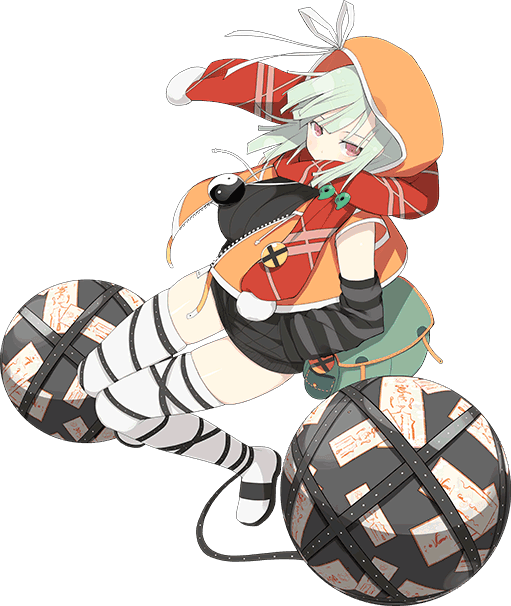 |
| She's got balls of steeeeel. |
Like I said in my review, Naraku
really should have been playable. She
fights similarly to the playable characters and has her own hidden ninpo
involving swinging and kicking her expanding flails around by her ankle and
blowing damaging bubble gum. Yes, she
actually blows bubbles as an attack.
Don’t underestimate the power of bubbles! Anyone who’s seen Jojo’s Bizarre Adventure,
Yu-Gi-Oh GX or Naruto should know the utility of a good weaponized bubble! Fucking bubbles!
Like other characters I also
enjoy little details like how Naraku keeps her hands in her sweater pockets
when she’s fighting because she never uses them and the way the balls are wrapped all around her legs instead of just her ankles. She’s a fun and appealing character design
that makes for an exciting shinobi smackdown in tune to some catchy fast-paced
music. It’s the usual fusion of a
certain musical style with traditional Japanese instruments, this time using
techno.
Her playability status is at
least corrected in Estival Versus, where she’s DLC with her own
transformation sequence even though she is very explicitly not a shinobi.
Naraku uses the old “I was not at
full power excuse” and gets away, but on the bright side, the main characters
have officially met up. Their first
exchange after the intense battle?
Homura somehow mistakens the word
“pawn” for “prawn” and thinks that Asuka is trying to upstage Homura’s running
impressions gag. That’s just silly. Homura is silly.
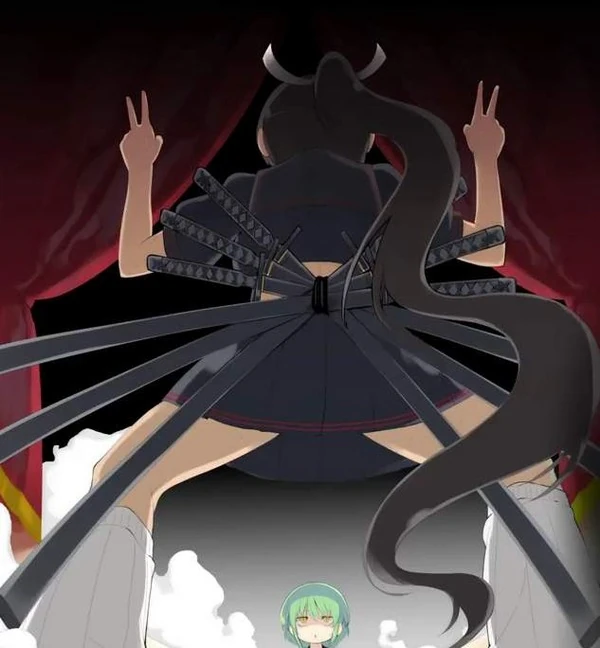 |
| She never stopped. |
The words being mistaken in
Japanese are definitely not “pawn” and “prawn”, but I’m not sure what word
Naraku is actually using. She’s saying
“koma”, but I doubt she’s calling the shinobi spinning tops because in Japanese
it’s spelled in katakana. It could be a
shortened word of some sort or slang. If
anyone knows please tell me in the comments.
With youma still tearing through Kyoto , the rivals of
Homura and Asuka’s teams have to pair up for some more cool tag attacks. Ikaruga and Yomi meet at the Kamo Riverbed,
where Yomi is still being stubborn and antagonistic, but thanks to the voice
talents of Ai Kayano you can hear the reluctance and desperation in her voice,
as though she’s unsure about Ikaruga, but still wants to stick to her
principles. They put aside their
differences to fend of a swarm of youma, including a new pair of red and blue
oni women youma, and at the end of it all they admit they make a pretty good
team.
 |
| Nice tag attack. |
Whether it’s together or against
one another, the idea of fighting together to strengthen mutual respect is a
common narrative element in shonen and indeed can apply to real life, where actions
can speak as loud as words. In addition
to the commonality between two fighters, how they act in battle can show their
priorities, trust and control over themselves, among other things. Senran Kagura 2 in particular reinforces it
with its co-op emphasis and it is one of the many things that have forged the
mutual respect of the two teams.
Katsuragi and Hikage are examples
of forging their rivalry and respect from battles against each other because
they get a lot of satisfaction from the other’s skills and neither of them are
malicious to each other. They’re
actually quite good friends, which is also shown through the co-op mechanics
here when they fight the tenth seat at the old capital.
Both Ikaruga and Katsuragi contemplate
the freedom Homura’s team has and how even though their lives are cushier,
shinobi still have to take orders they don’t always want to or risk punishment
like Katsuragi’s parents. Need I remind
you, Shinovi Versus said Katsuragi’s parents failed their mission for refusing
to kill someone because they didn’t want to hurt the target’s family. It hints at how Hanzo academy isn’t quite the
paragon of good and justice it might look like at first glance. At least they aren’t making the Hanzo girls
kill anyone though, right?
Right?
After Katsuragi and Hikage beat
down the tenth seat, Naraku and the still-unnamed little girl take advantage of
the situation and finish it off. It’s
portrayed offscreen (sadly), but the girl crushes the tenth seat and then searches
its remains for a small red orb (akadama).
Apparently the strongest youma have these red orbs in them, as Katsuragi
points out that the lesser ones they’ve been fighting didn’t have anything like
it.
That’s already weird enough, but
the little girl then proceeds to happily eat the little orb that came out of
the bloodthirsty monster. As she said
earlier, it’s going to make her stronger.
Actually that may not be so weird when you consider grown adults try to taste fucking Switch cartridges specifically because of a design to prevent that.
The whole situation gets more curious with each scene. Just like the opening scroll, this and Naraku’s dialogue referring to things yet to be revealed sets up a whole lot of mysteries.
Actually that may not be so weird when you consider grown adults try to taste fucking Switch cartridges specifically because of a design to prevent that.
The whole situation gets more curious with each scene. Just like the opening scroll, this and Naraku’s dialogue referring to things yet to be revealed sets up a whole lot of mysteries.
Haruka meets up with Hibari and
Yagyuu at Kiyomizu-Dera during the struggle and she offers to help them with
her mission, since they’re such good friends.
When she first sees Naraku and the little girl arrive on the scene,
Haruka thinks they look like ordinary people, but that very quickly changes.
Naraku has officially stopped
trying to begrudgingly work with the shinobi now that they’re out to get her,
so instead she’s doing her damnedest to bring out as much youma as she can,
presumably for more of those red orbs, first by striking Yagyuu to have her
blood draw out more of them. With Yagyuu
out of commission for the time being, Haruka has Hibari fight off the youma
while she deals with Naraku. As usual,
Yagyuu is overprotective and doesn’t want to put Hibari in danger like that and
even Naraku says it’s dangerous, but Haruka trusts Hibari. She’s had to fight Hibari and she knows
Hibari’s a strong shinobi. This is
different from Yagyuu, who encourages Hibari, but still keeps trying to protect
her and doesn’t let her fend for herself.
The name of the mission even is “The Power of Trust.”
 |
| Ever see the rabbit in Monty Python? Well that's Ninto. |
Yagyuu and Haruka fighting over
Hibari’s attention is a recurring gag in the versus games, which is
funny, but in a situation like this it’s played much more earnestly. It’s another case of control vs.
freedom. Haruka is hedonistic and wants
Hibari to do what she wants, which can be linked to her past as a show child
where she was miserable because her parents never let her express herself. Yagyuu, on the other hand, keeps coddling
Hibari and wants her close because she doesn’t want to lose her like she lost
her little sister.
Now Yagyuu has to accept that
Hibari may not need her to protect her anymore, which I’m sure many people can
relate to when it comes to their daughters or little sisters. The feeling is amplified by Yagyuu’s traumatic past. We’ve seen the shinobi use the concept of the
katana and shield to protect something important to them, but what happens when
what they’re protecting doesn’t want it?
As for the fight with Naraku,
it’s the same as before, but a little more challenging now that you have to
fight her alone with Haruka. Luckily
Naraku doesn’t have as much health because she’s still injured from the fight
with Homura and Asuka. Regardless, it’s
neat getting to see Haruka fight a powerful foe like this singlehandedly
because she’s supposed to be one of the oldest and wisest of all the shinobi
students. She’s kind of like a big
sister and you can count on big sis to fight off those bullies!
Unfortunately it was just a ploy
to bring out more youma and there were already enough so now shit’s REALLY
hitting the fan!
 |
| I sure used those brush hair pieces for Haruka. |
More shit hits the fan when Kiriya meets Asuka at Kitano Tenmanguu with an update on the Hanzo student’s assignment: the capture mission
has been changed to an assassination.
They want those girls dead.
Now more than ever, Asuka’s
idealism is being challenged. She has
always wanted to understand the people she fights against, but now she is being
told to kill people she doesn’t know, that the higher ups won’t tell her about,
who have done nothing but antagonize her friends and very clearly doesn’t want
to be friends. Even if she doesn’t want
to, Asuka still needs to fulfill her mission.
Not because she wants to, but because she has to. It’s part of what it means to be a good
shinobi. But is it really right?
 |
| It still bugs me that Kiriya is never onscreen for any of this! |
And for people who haven’t played
it that are optimistic there’s a conspiracy going on, I’ll tell you right now,
there isn’t. There’s no
string-pulling. The ninja elders have a
legitimate reason for it. It’s just that
their reasons should not matter to someone whose duty is to do their mission.
As that’s going on Yagyuu goes
through a bit of an existential crisis, believing that she has nothing to fight
for anymore, but Mirai’s pleas for her to help her fight the youma at Aoibashi
and stop moping make Yagyuu realize that there are still other people that need
help and that even if Hibari doesn’t always need her, there will still be times
where Yagyuu will be needed and that is what she will fight for. Leave it to Mirai’s abrasive, straightforward
attitude to get through to Yagyuu’s clouded, reserved thinking. Even though they were great foils for each other, Yagyuu and Mirai didn't get to know each other very personally before this point. In fact Mirai even points out that they refer to each other by name for the first time. Like with Yomi and Ikaruga, Kitajima is good at filling in where there should be more.
Now that the teams have met up
and have established their synergy, the chapter reaches a conclusion. Not a giant epic youma battle like the first
two, but with everything built up reaching a peak. Asuka catches up with Naraku just as the
little girl is eating another red orb, but this time, something happens. The little girl transforms into what looks
like a teenage girl in a sailor uniform.
Instead of acting childish, she now talks calmly and politely, with
little hint of emotion, and finally reveals her name: Kagura, the slayer of
youma.
The red orbs are part of an
“awakening ritual” that allows Kagura to get stronger and become some sort of
youma-slaying entity once she consumes enough and she and Naraku are hell-bent
on doing that no matter what they have to do or who they have to kill. Since these blood-red orbs are a core essence
of youma, this explains what the opening scroll meant by “with the blood of
youma it will bloom.” That’s one cryptic
mystery solved.
So she’s some kind of human that
eats youma to turn into a super form and apparently exists specifically for
killing youma. If you swapped the words
“human” and “youma” in that sentence it kind of reminds me of…. Nah. Never mind.
Maybe it’s just me, but I think
the way she transforms from a cheerful, playful child to a stoic, polite
teenager is supposed to be some kind of Japanese subtext regarding the
compliance expected of people as they get older. It kind of fits with the theme of
individualism if that’s what Kitajima was going for.
Asuka seriously seems ready to
kill the two, but Homura, of all people stops her before she can and their
ideologies butt heads. Homura believes
her slaying youma can help them with the situation, while Asuka says Kagura’s
way causes way more collateral damage.
Both have good points, but it’s kind of rendered moot when ultimately
Asuka’s decision is influenced by her orders to kill them. Homura is disgusted by Asuka’s
absolutism. She’s from a place that values
individualism and giving people a
chance and she also knows that just because someone is in charge doesn’t mean
they’re always right, like with Dougen.
There’s no way Homura can let Asuka go off killing someone without good
reason, so she aims to stop her with force.
This is a brilliant way of
turning the tables from the end of the first chapter. Instead of fighting Homura with Asuka, it’s
the opposite and Homura is the one who seems sensible and cares about protecting
others this time. Asuka belives there
can be good in evil, which is part of her optimism and Homura believes there
can be evil in good, which is part of her cynicism. It’s another way of showing that who the enemy
is is a matter of perspective and that everyone has the potential for good and
evil.
In the end they’re unable to
agree. Asuka is dead set on following
the path of the good shinobi no matter what, so Homura simply leaves Asuka to
her own devices, ending the chapter on a gripping cliffhanger. Will Asuka kill someone for the sake of her
orders? Will Kagura and Naraku succeed
in their plan? What will happen if they
do? How will the rest of the renegades
react to their rival’s new hit order?
You have to keep playing to find out!
Chapter 3 is another set-up
chapter, this time for the main plot. It
introduces the new characters and new enemies, sets up ambiguous details and
then pays some of them off, gives the rivals screentime for character
development and gives the player more tag team combinations, bosses and youma
to keep the gameplay interesting.
With bosses no longer taking up
the majority of the play time, chapter 3 also allows characters to better showcase
their musical leitmotifs when they transform.
I particularly like Ikaruga’s bled of elegant Japanese instruments and
rhythmic guitar.
I also like Yagyuu’s. It reminds me of the hard-hitting duel music
from the first chapter, but with a recognizable melody.
After already spectacular opening
chapters, chapter 3 made me want to play more.
Kitajima knows how to pace the story and keep the players invested with
meaningful character dichotomy and development, which continues into chapter 4.


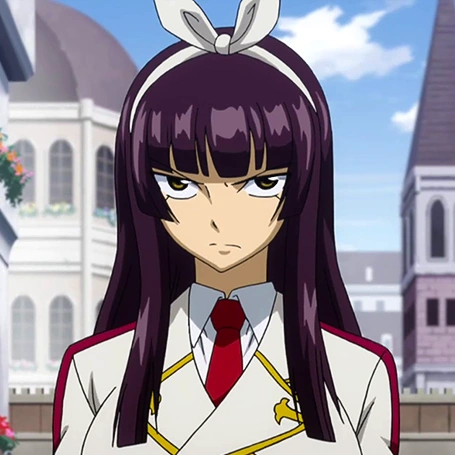
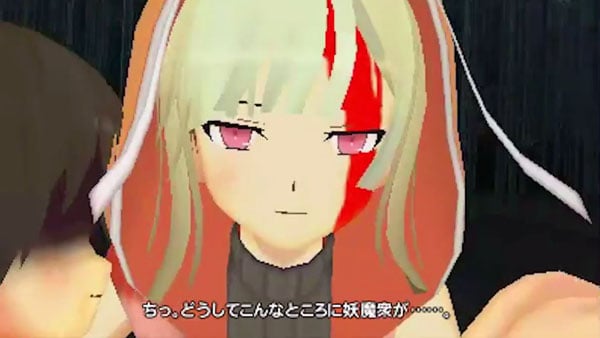




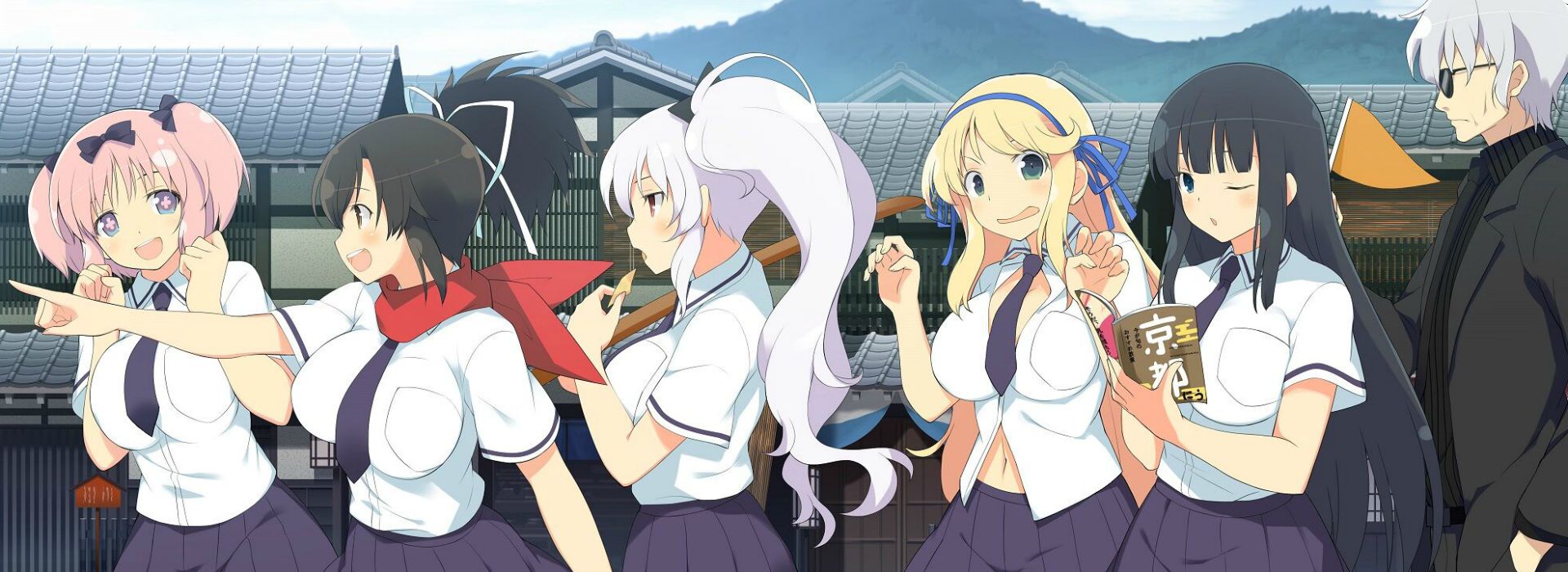

_6.png/revision/latest?cb=20151013033906)
---midori.jpg)
_6.png/revision/latest?cb=20151013025955)


_6.png/revision/latest?cb=20151013033426)
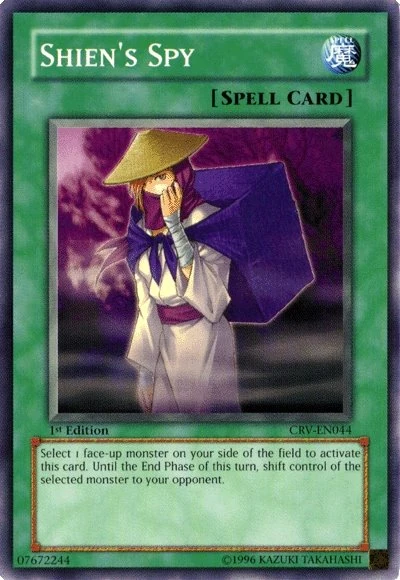


_6.png/revision/latest?cb=20151013024351)
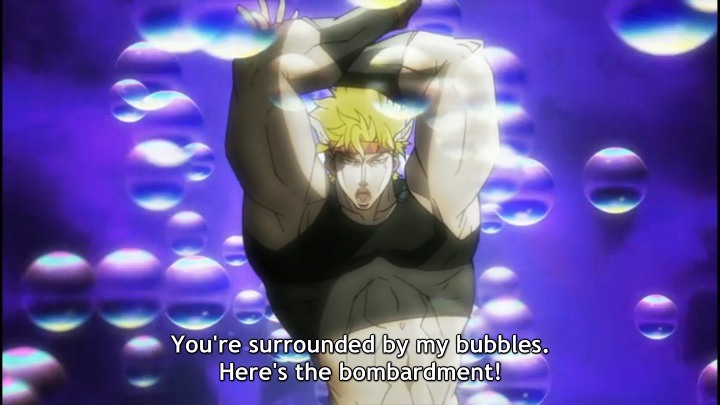

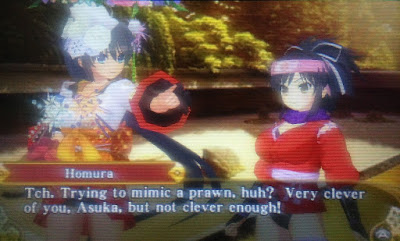
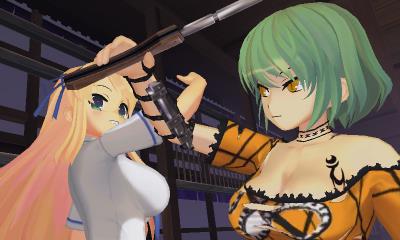







No comments:
Post a Comment